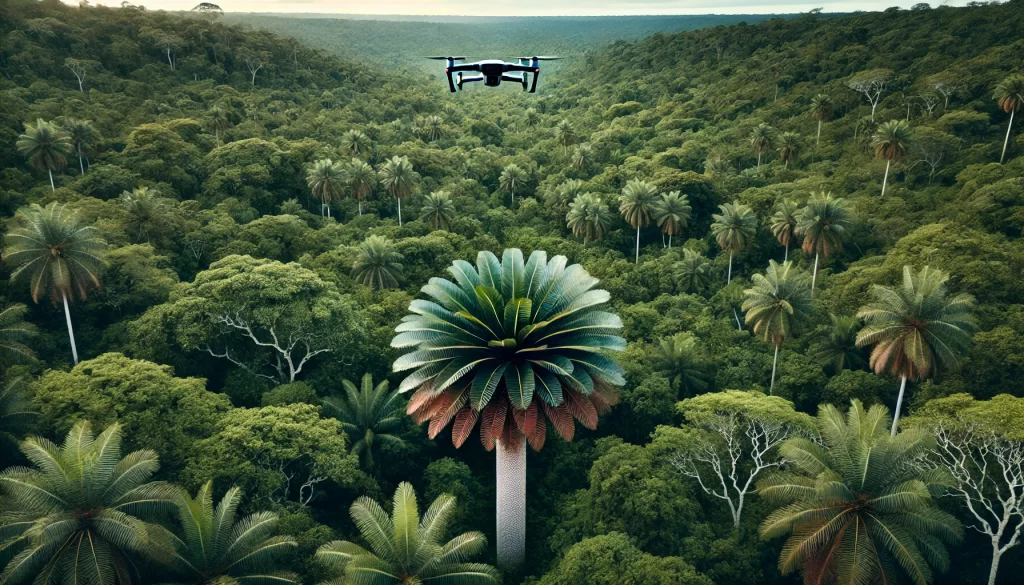Introduction
In the dense forests of South Africa, a unique and ancient plant, known as Encephalartos woodii or Wood’s cycad, faces a lonely existence. Discovered in 1895 by botanist John Medley Wood, this plant is the only known male of its species, making it impossible for it to reproduce naturally. Scientists are now using modern technology, including drones and artificial intelligence (AI), to search for a female counterpart that could help save this rare species from extinction.
Discovery and Characteristics
Wood’s cycad, a type of cycad that predates dinosaurs, was found in the Ngoye Forest Reserve in KwaZulu-Natal, South Africa. Cycads are ancient seed plants with male and female reproductive structures on separate plants. Unfortunately, no female Encephalartos woodii has ever been found, and all existing specimens are clones of the original male plant. The species first emerged around 300 million years ago and is considered one of the most primitive types of seed plants.
Cycads, unlike many other plants, have distinct male and female individuals. The male cycad produces pollen cones, while the female cycad would produce seed cones. However, since only a male specimen has been found, the plant can only propagate through offshoots. This method of asexual reproduction involves the parent plant sending out shoots that develop into new plants. In the 20th century, botanists removed some of these offshoots and transplanted them around the world. Today, about 500 separate plants derived from the original Wood’s cycad are housed in botanical gardens globally.
Propagation Efforts
Despite its solitary existence, efforts have been made to propagate Wood’s cycad. Botanists have removed offshoots from the original plant and transplanted them to various botanical gardens worldwide. However, without a female, these plants cannot engage in sexual reproduction, which is vital for the species’ long-term survival. Sexual reproduction is necessary to produce genetic diversity, which helps plants adapt to changing environments and resist diseases.
The Role of AI and Drones
To find a potential mate for Wood’s cycad, scientists have launched an ambitious project involving drones and AI. Drones equipped with cameras fly over the Ngoye Forest, capturing images that are then analyzed by AI algorithms. These algorithms have been specially trained to identify cycads from aerial views, even distinguishing them from similar-looking palm trees.
Laura Cinti, a research fellow at the University of Southampton and co-founder of the art and science collective C-LAB, explains the project’s innovative approach: “We adopted detection models from the palm oil industry and trained them to recognize the unique shape of cycads.” Surveys conducted in 2022 and 2024 have scanned over 195 acres of the 10,000-acre Ngoye Forest, but much more ground remains to be covered.

The AI system uses a computer vision model called YOLOv8 to analyze the thousands of images captured by the drones. These images are taken in five different wavelengths to help identify the cycads’ unique spectral signature, making it easier to distinguish them from other trees. The researchers also generated synthetic maps with cycads in various environments to improve the model’s ability to recognize them in diverse contexts.
Challenges and Hopes
The search for a female Encephalartos woodii is fraught with challenges. The forest’s hilly terrain and frequent cloud cover make it difficult to capture clear images. Moreover, previous surveys by other scientists have been unsuccessful. Despite these hurdles, the research team remains hopeful.
“We can guide some of these drones using a first-person perspective, enabling us to do fine navigation and obtain detailed close-ups,” says Cinti. If a female cycad is found, it would likely be removed from the wild to a controlled environment where pollination could be managed, either naturally or artificially. The ultimate goal is to produce fertile, healthy seedlings that could be reintroduced into their native habitat.
The Next Steps
If a female Encephalartos woodii is located, scientists plan to carefully manage the pollination process. In a controlled environment, they can ensure that the seeds produced are healthy and have the best chance of growing into mature plants. These new plants would then be carefully cultivated and, once robust enough, reintroduced into the wild to help re-establish the species in its natural habitat.
Dr. Cinti, who is leading this project, expresses her inspiration and hope: “I was very inspired by the story of the E. woodii, it mirrors a classic tale of unrequited love. I’m hopeful there is a female out there somewhere, after all, there must have been at one time. It would be amazing to bring this plant so close to extinction back through natural reproduction.”
Conclusion
The story of Wood’s cycad is a poignant reminder of the fragility of our planet’s biodiversity. Through the combined efforts of technology and science, there is hope that this ancient species can be saved from the brink of extinction. As the search continues, the world’s loneliest plant may soon find a companion, ensuring its survival for future generations.
Scientists remain committed to this quest, driven by the possibility of witnessing a revival of a species that has existed since before the dinosaurs. The success of this project could not only save Encephalartos woodii but also inspire similar conservation efforts for other endangered species worldwide.
This article is based on the following articles:
https://www.bbc.com/news/articles/ce99v9z0529o
https://www.npr.org/sections/krulwich/2011/05/10/136029423/the-loneliest-plant-in-the-world

Background Information
Cycads are a group of ancient seed plants that have been around for over 300 million years, even before the time of the dinosaurs. They belong to a plant group called Gymnosperms, which also includes conifers like pine trees. Gymnosperms are known for having seeds that are not enclosed in fruits. Instead, their seeds develop on the surface of cones.
Characteristics of Cycads
- Appearance: Cycads look somewhat like palm trees, with large, compound leaves that grow in a rosette around a central trunk. Despite their appearance, they are not closely related to palms.
- Reproduction: Cycads are dioecious, meaning that individual plants are either male or female. Male plants produce pollen cones, while female plants produce seed cones. For fertilization to occur, pollen from a male plant must reach the ovules on a female plant.
- Longevity: Cycads grow very slowly but can live for a very long time, often hundreds of years.
- Habitat: Cycads typically grow in tropical and subtropical regions around the world. They prefer well-drained soils and often grow in areas with seasonal climates, where they can experience periods of drought.
Conservation of Endangered Plants
Conservation is the practice of protecting and preserving natural resources and the environment. For plants, this often involves:
- Habitat Protection: Ensuring that the natural habitats where plants live are protected from destruction and degradation. This can involve creating reserves and parks.
- Propagation Programs: Growing plants in botanical gardens and other controlled environments to ensure their survival. This can include both natural and artificial methods of reproduction.
- Research and Monitoring: Conducting scientific studies to understand the needs of endangered plants and monitoring their populations to track their health and numbers.
- Public Education: Teaching people about the importance of plants and the need to protect them. This can help build support for conservation efforts.
Role of Technology in Conservation
Modern technology plays a crucial role in the conservation of endangered species:
- Drones: These are unmanned aerial vehicles that can fly over difficult-to-reach areas and take detailed photographs and videos. They help scientists study and monitor plant populations in remote or dangerous locations.
- Artificial Intelligence (AI): AI involves computer systems that can perform tasks normally requiring human intelligence, such as visual perception, speech recognition, and decision-making. In plant conservation, AI can analyze large amounts of data quickly and accurately, such as identifying plants from aerial images.
- Genetic Analysis: Scientists can study the DNA of plants to understand their genetic diversity, which is important for their survival. This information can help in breeding programs to ensure healthy populations.
The Importance of Biodiversity
Biodiversity refers to the variety of life on Earth, including plants, animals, fungi, and microorganisms. High biodiversity is important for several reasons:
- Ecosystem Health: Diverse ecosystems are more resilient and can recover from disturbances such as diseases, climate change, and natural disasters.
- Human Benefits: Biodiversity provides humans with resources such as food, medicine, and materials. Many medicines are derived from plants, and a diverse range of crops ensures food security.
- Ecological Services: Plants and other organisms provide essential services such as oxygen production, water purification, and soil fertility.
Challenges in Conservation
- Habitat Destruction: Human activities such as deforestation, urbanization, and agriculture can destroy or fragment habitats, making it difficult for plants and animals to survive.
- Climate Change: Changes in climate can alter habitats and affect the availability of water, nutrients, and other resources that plants need to survive.
- Pollution: Air, water, and soil pollution can harm plants and disrupt their growth and reproduction.
Invasive Species: Non-native plants and animals can outcompete native species for resources, sometimes leading to the decline or extinction of native species.
Please subscribe to Insight Fortnight, our biweekly newsletter!
